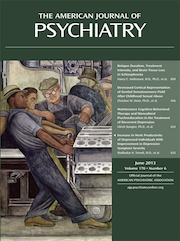Transitions in Illicit Drug Use Status Over 3 Years: A Prospective Analysis of a General Population Sample
Abstract
Objective
The authors examined 3-year transitions among nonuse, asymptomatic use, and problem use of illicit drugs for U.S. adults in the general household population.
Method
Data were from the nationally representative National Epidemiologic Survey on Alcohol and Related Conditions, a study of 34,653 adults interviewed twice, 3 years apart. Respondents were categorized on three mutually exclusive categories of baseline drug status: past-year nonusers (N=32,675), past-year asymptomatic drug users (N=861), and past-year symptomatic drug users (N=1,117). Symptomatic drug use, or problem use, was defined as presence of one or more symptoms that operationalize DSM-IV drug abuse and dependence criteria. The authors assessed sociodemographic, health, substance use, and psychiatric covariates for association with 3-year transitions to different status categories.
Results
Among baseline nonusers, 95.4% continued to be nonusers at follow-up, 2.1% became asymptomatic users, and 2.5% developed problem use. Among baseline asymptomatic users, 66.6% had stopped using drugs at follow-up, 14.3% continued to be asymptomatic users, and 19.1% had developed problem use. Nearly half (49.0%) of those with problem use at baseline had stopped using drugs at follow-up, 10.9% had transitioned to asymptomatic use, and 40.1% continued to have problem use. Younger age, male sex, white race, and not being married were associated with progression from nonuse to use or problem use, as were alcohol and tobacco use and disorders, major depression, and schizotypal, borderline, and narcissistic personality disorders. Panic disorder and avoidant personality disorder were associated with less progression.
Conclusions
Transitions in drug use status are common. The finding that alcohol and tobacco variables and co-occurring psychopathology are important correlates of transitions suggests the value of addressing all co-occurring disorders and substance use in patient assessments and treatment planning, both to prevent adverse transitions and to promote positive transitions.



